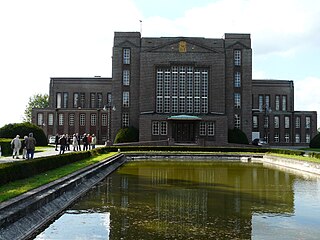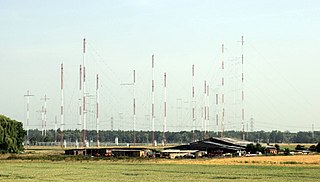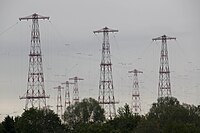International broadcasting consists of radio and television transmissions that purposefully cross international boundaries, often with then intent of allowing expatriates to remain in touch with their countries of origin as well as educate, inform, and influence residents of foreign countries. Content can range from overt propaganda and counterpropaganda to cultural content to news reports that reflect the point of view and concerns of the originating country or that seek to provide alternative information to that otherwise available as well as promote tourism and trade. In the first half of the twentieth century, international broadcasting was used by colonial empires as a means of connecting colonies with the metropole. When operated by governments or entities close to a government, international broadcasting can be a form of soft power. Less frequently, international broadcasting has been undertaken for commercial purposes by private broadcasters.

In radio, longwave, long wave or long-wave, and commonly abbreviated LW, refers to parts of the radio spectrum with wavelengths longer than what was originally called the medium-wave broadcasting band. The term is historic, dating from the early 20th century, when the radio spectrum was considered to consist of longwave (LW), medium-wave (MW), and short-wave (SW) radio bands. Most modern radio systems and devices use wavelengths which would then have been considered 'ultra-short'.

Radio Netherlands was a public radio and television network based in Hilversum, producing and transmitting programmes for international audiences outside the Netherlands from 1947 to 2012.

Jülich is a town in the district of Düren, in the federal state of North Rhine-Westphalia, Germany. As a border region between the competing powers in the Lower Rhine and Meuse areas, the town and the Duchy of Jülich played a historic role from the Middle Ages up to the 17th century.
Vatican Radio is the official broadcasting service of Vatican City.
The Orfordness transmitting station was a major radio broadcasting facility at Orford Ness on the Suffolk coast in the United Kingdom able to broadcast to much of Europe. It closed in May 2012 after more than 30 years of service. In 2017 Radio Caroline started broadcasting from the site, though not with the same intended coverage of an audience in Europe as the original station.
Deutschlandfunk is a public-broadcasting radio station in Germany, concentrating on news and current affairs. It is one of the four national radio channels produced by Deutschlandradio.

ALLISS is a somewhat rotatable antenna system for high power shortwave radio broadcasting in the 6 MHz to 26 MHz range. An ALLISS module is a self-contained shortwave relay station that is used for international broadcasting.

The Heilsberg transmitter was a large radio transmitting station operated by the Reichs-Rundfunk-Gesellschaft between 1930 and 1945 in the German Province of East Prussia. It was sited approximately 3 kilometres (1.9 mi) northwest of Heilsberg, on the road to Preußisch Eylau (Bagrationovsk).

The Woofferton transmitting station is owned and operated by Encompass Digital Media, as one of the BBC's assets which were handed over as part of the privatization of World Service distribution and transmission in 1997. It is the last remaining UK shortwave broadcasting site, located at Woofferton, south of Ludlow, Shropshire, England. The large site spreads across into neighbouring Herefordshire.

The Jülich shortwave transmitter, operated by Deutsche Telekom / T-Systems, was a part of the shortwave broadcasting facility at Jülich, Germany.
Golm transmitter or Sender Golm was a medium wave broadcasting facility on the area of a former Reichsarbeitsdienst officer candidate school at Kuhforter Damm in Golm near Potsdam. It entered service in 1948 as the central broadcast transmitter for Brandenburg state. Until 1979 it used a wooden lattice tower of 98 m (322 ft) height with a horizontal wooden cross on its top as its antenna support. The ends of the beams of this cross were connected with wires. From the centre of each of these horizontal wires, a vertical wire was run down to the antenna tuner which was located in a building under the feet of the tower construction. The antenna of Golm transmitter consisted therefore of 4 T-antennas connected in parallel, forming an omnidirectional antenna with a natural wavelength of 528 m. The transmitter was built from second-hand parts obtained by dismantling a site in Reichenbach, Upper Lusatia. Test transmissions were undertaken on 16 April 1948, and from 1 May 1948 the facility operated on 564 kHz.

Georg Wilhelm Alexander Hans Graf von Arco was a German physicist, radio pioneer, and one of the joint founders of the "Society for Wireless Telegraphy" which became the Telefunken company. He was an engineer and the technical director of Telefunken. He was crucial in the development of wireless technology in Europe.

Nauen Transmitter Station in Nauen, Havelland district, Brandenburg, Germany, is the oldest continuously operating radio transmitting installation in the world. Germany's first high power radio transmitter, it was founded on 1 April 1906 by Telefunken corporation and operated as a longwave radiotelegraphy station through World War II, and during World War I became Germany's main link with the outside world when its submarine communications cables were cut. Upgraded with shortwave transmitters in the 1920s it was Germany's most advanced long range radio station, continually upgraded with the latest equipment and serving as an experimental station for Telefunken to test new technology. At the end of World War II, invading Russian troops dismantled and removed the transmitting equipment. During the Cold War it served as the GDR's international shortwave station Radio Berlin International (RBI), and was the East Bloc's second most powerful radio station, disseminating Communist propaganda to other countries. Since German Reunification in 1991 it has been operated by Deutsche Telekom, Germany's state telecommunication service. The original 1920 transmitter building designed by architect Herman Muthesius is still used; it is one of the many remaining buildings designed by that architect that is a protected cultural heritage site.

Shortwave relay stations are transmitter sites used by international broadcasters to extend their coverage to areas that cannot be reached easily from their home state. For example, the BBC operates an extensive net of relay stations.

CKCX was the call sign used for the Canadian Broadcasting Corporation's shortwave transmitter complex near Sackville, New Brunswick at the Tantramar Marshes. The Sackville Relay Station was operated by Radio Canada International and broadcast its programming around the world as well as relay transmissions from several foreign shortwave broadcasters. Domestically, it transmitted broadcasts on 9.625 MHz to northern Quebec by CBC North, the James Bay Cree Communications Society and Taqramiut Nipingat, the Inuit communications society of the Nunavik region of northern Quebec. The CKCX designation was assigned after CBC Radio's CBA, under whose licence the Sackville complex originally operated, moved to Moncton in 1968. Sackville was also used by Radio Japan, China Radio International, Voice of Vietnam, BBC World Service, Deutsche Welle and Radio Korea as part of a transmitter time exchange agreement.
RDP Internacional – Rádio Portugal, is an international radio broadcasting station of Rádio e Televisão de Portugal. It aims at overseas Portuguese communities in Europe, Africa, South America, North America, India/Middle East as well as East Timor.

Curtain arrays are a class of large multielement directional radio transmitting wire antennas, used in the short-wave radio bands. They constitute a type of reflective array antenna, consisting of multiple wire dipole antennas, suspended in a vertical plane, often positioned in front of a "curtain" reflector made of a flat vertical screen of many long parallel wires. These are suspended by support wires strung between pairs of tall steel towers, reaching heights of up to 90 m high. Primarily employed for long-distance skywave transmission, they emit a beam of radio waves at a shallow angle into the sky just above the horizon, which is then reflected by the ionosphere back to Earth beyond the horizon. Curtain arrays are extensively used by international short-wave radio stations for broadcasting to large areas at transcontinental distances.

Wireless Hill Park is a 40-hectare (99-acre) park in Ardross, Western Australia that is the location of the former Applecross Wireless Station, an early radio station in Western Australia. The station buildings have been preserved and now house the Wireless Hill Museum. The site is listed in the Register of the National Estate and the State Register of Heritage Places.
Berlin-Köpenick transmitter was a transmission facility for broadcasting on medium wave, short wave, and VHF in Berlin-Köpenick, Germany, near the suburb of Uhlenhorst, after which it was occasionally named.




















